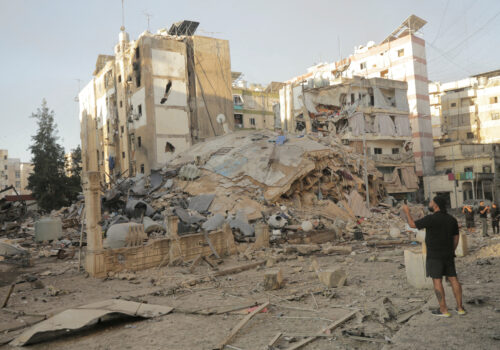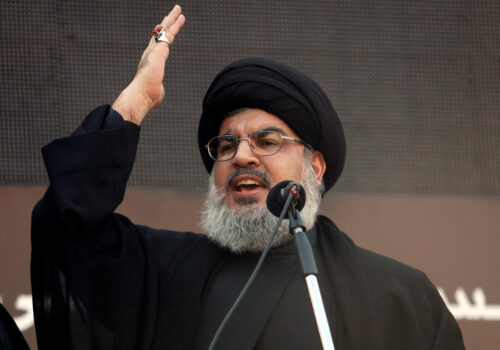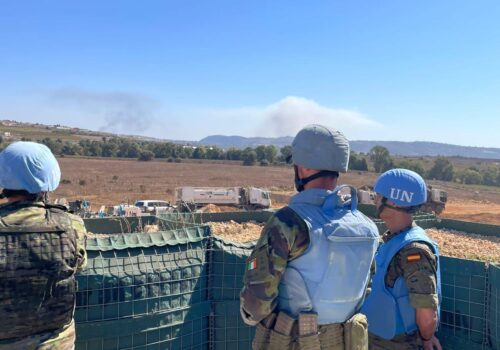A ceasefire happened in Lebanon, but Israel seems to have missed the memo
A fragile ceasefire took effect on November 27, ending the thirteen-month conflict between Hezbollah and Israel prompted by the October 7, 2023, attack, but the Israel Defense Forces (IDF) seems to have missed the memo. Within hours of the 4 a.m. ceasefire coming into force, Israeli troops inside Lebanon opened fire at vehicles as tens of thousands of Lebanese who had earlier fled the fighting attempted to return to their homes. In the town of Khiam, the scene of fierce fighting in October and November, three journalists were wounded by Israeli gunfire while covering the return of residents. The same day, the IDF slapped a ban on Lebanese returning to dozens of border villages, declaring them a “restricted area,” and imposed a curfew from 5 p.m. to 7 a.m. south of the Litani River, which runs anywhere between three and thirty kilometers north of the border.
The thirteen-point ceasefire plan brokered by the United States and France calls for the Lebanese Armed Forces (LAF) to deploy into the southern border district and for the IDF to withdraw from Lebanese territory within sixty days. However, instead of withdrawing, Israeli forces have advanced deeper into Lebanon in a number of locations.
Israel has also staged air strikes well north of the southern Lebanon border area. On November 28, Israeli jets struck what Israel said was a Hezbollah weapons storage facility near Sidon. On December 2, Israel aircraft bombed an LAF positionon Lebanon’s northern border with Syria, wounding an LAF soldier. Other air strikes have targeted villages in south Lebanon, killing and wounding several Lebanese.
SIGN UP FOR THIS WEEK IN THE MIDEAST NEWSLETTER
France reportedly accused Israel on December 1 of breaching the ceasefire fifty-two times. Even the United States has reportedly chided Israel and urged it to calm down.
On the afternoon of December 2, Hezbollah lobbed a pair of mortar rounds toward an Israeli army outpost in the Shebaa Farms area on the edge of southeast Lebanon, in what the group said was an “initial warning defensive response” to the repeated Israeli violations. Israel responded by staging a series of air strikes across south Lebanon.
Israeli Defense Minister Israel Katz warned that, if the ceasefire broke down, the Lebanese state would no longer be immune from attack.
“If until now, we have distinguished between the state of Lebanon and Hezbollah . . . this will no longer be [the case if the ceasefire breaks down],” he said during a tour of northern Israel.
A week after the ceasefire began, it is evident that the security paradigm of mutual deterrence between Hezbollah and Israel, which led to a tense calm for seventeen years along the Lebanon-Israel border, is all but over. Where Israel was once hesitant to take action against Hezbollah in case it triggered an escalation of unwanted cross-border violence, the calculus has mostly swung the opposite way. Israel’s post-ceasefire shelling and air strikes indicate that it will police the agreement by fire, irrespective of any response by Hezbollah.
Although Hezbollah has claimed a victory against Israel, its decimated veteran leadership will need to do some serious soul searching going forward and mull the lessons from its serious miscalculation of opening a support front for Hamas in Gaza a year ago. Initially, the support front was a simmering low-intensity tit-for-tat conflict along the Blue Line—the United Nations term for Lebanon’s southern border—that saw Hezbollah targeting Israel border positions daily and Israel retaliating with drone strikes and shellfire.
Hezbollah expected that Israel would not overreact to the daily slew of attacks, even though they had led to the evacuation of more than twenty-eight communities, including the town of Kiryat Shemona in the Galilee panhandle. Hezbollah was so confident that it could control the conflict dynamics that it began linking the fate of the support front along the Blue Line to the war in Gaza. This was arguably the greatest strategic blunder Hezbollah has made in its forty-two-year history. By stating that it would only halt its attacks once the war in Gaza was over, Hezbollah had effectively handed over the decision-making process to Hamas and Israel. If neither Hamas nor Israel could strike a ceasefire deal, Hezbollah would be obliged to keep attacking Israeli troops along the border regardless of the cost.
By early 2024, it was becoming evident that Hezbollah was seeking a face-saving off-ramp to end the support front, which was increasingly imposing a cost on the organization. Tens of thousands of Lebanese civilians had fled the violence in south Lebanon and suffered the destruction of their properties and loss of livelihoods. Worryingly for Hezbollah, it was becoming clear that Israeli intelligence had penetrated deep within the party, allowing it to track and kill senior field commanders across south Lebanon and elsewhere.
One of the first to be killed, Wissam al-Tawil, a senior figure in the elite Radwan Brigade, died when an improvised explosive device detonated next to his car near his home in the southern village of Khirbet Silm on January 8. A friend of Tawil’s told me that the slain commander had not been home for six months, never carried a cell phone, and swapped cars multiple times a day—yet the Israelis were still able to locate and kill him. He was not the only one. Numerous commanders, whose names were not known publicly before they died, were killed in air strikes. One of them, Ali al-Debs, survived two attempted assassinations over a three-week period before being killed on February 15 in an air strike on the house in which he was recovering from wounds. In June and July, Israel assassinated the heads of the Nasr and Aziz units, two of Hezbollah’s top fighting formations deployed in south Lebanon.
Furthermore, as the losses mounted within Hezbollah and the destruction increased, there was a sense of frustration among the cadres and supporters that the organization was fighting with one hand tied behind its back. Although Hezbollah was using some advanced anti-tank missiles, such as the optically guided Almas and long-range Iranian versions of the Russian AT-14 Spriggan, most of the weapons employed were legacy systems. They included unguided rockets such as the 122-milimeter (mm) Grad, the 240mm Falaq-1, and the 333mm Falaq-2, which have limited ranges and impacts. Lying untouched in Hezbollah’s underground arsenals were larger and more accurate systems such as the Fateh-110 family of surface-to-surface missiles, which carry 500-kilogram warheads, can strike within meters of their targets, and have ranges of several hundred kilometers depending on the version. The source of this frustration was Iran, which refused to allow Hezbollah to use its more sophisticated systems in case such action led to further escalation and a possible major war. Iran had no problem with Hezbollah’s support front along the Blue Line, but this was supposed to be a sideshow, not the main event. These advanced weapons systems were a component of Iranian deterrence to stave off the possibility of Israel one day launching a major attack against the Islamic Republic’s nuclear facilities. They were not to be wasted on helping Hamas in Gaza.
Nevertheless, the Hezbollah leadership might have noticed the frustration within the ranks because, around mid-April, the group began to escalate its actions. It fired rockets in larger numbers and deeper into Israel. It expanded its target set to strike a broader number of Israeli army facilities, including military-industrial centers. Significantly, it greatly increased the use of suicide drones, which proved challenging for the Israelis to intercept because of their low altitude, speed, and unpredictable flight patterns.
Tensions steadily mounted during the summer months. On July 30, Israel assassinated Fuad Shukr, Hezbollah’s top military commander, in a drone strike in the southern suburbs of Beirut. His death was a response to the killings of twelveyoungsters when what was almost certainly an errant Hezbollah rocket struck a playing field in the Druze village of Majdal Shams in the Golan Heights. Hezbollah vowed revenge for Shukr’s death, but it took three weeks before the retaliation came in the form of more than three hundred rockets and suicide drones fired into Israel. Israel said that it shot down all the drones and that only minor damage had been inflicted. Even Hezbollah’s support base was less than impressed with the retaliatory attack.
In hindsight, it might have been this moment when Israel decided to call Hezbollah’s bluff. For the preceding ten months, it had been clear that Hezbollah had no taste for engaging in a large-scale war with Israel and sought to restrict its actions to low-level daily attrition along the Blue Line. But in the days after the Hezbollah retaliation for Shukr, Israel stepped up the number of daily air strikes, hitting multiple targets in single sorties. In mid-September, in a stunning intelligence coup, thousands of booby-trapped pagers and walkie-talkies carried by Hezbollah personnel exploded, killing more than thirty and wounding nearly 3,500.
In the following days, Israel assassinated a swath of Hezbollah’s top political and military leadership, including the veteran secretary general, Hassan Nasrallah. On September 23, Israel launched Operation Northern Arrow, a massive series of air strikes against Hezbollah targets across south Lebanon and the Bekaa Valley. Israel claimed that 1,600 targets were struck on the first day. Nearly 558 people were killed in the first twenty-four hours of the raids—the largest loss of life in Lebanon in a single day since the 1975–1990 civil war. On October 1, Israeli troops crossed into Lebanese territory to carry out a series of focused raids to locate and destroy Hezbollah’s military infrastructure adjacent to the Blue Line. Hezbollah fighters confronted Israeli troops on the ground. They began firing some of Hezbollah’s more advanced precision-guided missiles into Israel from October, but these were smaller-caliber systems and fired in too low of numbers to have much effect.
Now that a shaky ceasefire has taken hold, Iran and Hezbollah will need to assess if that shattered deterrence, which had proven effective in the seventeen years between 2006 and October 2023, can be—or even should be—restored. If Hezbollah had been allowed to fight the way its lower-ranking cadres had wanted, with recourse to the heavier systems, the war could have been much more damaging to the Israeli domestic front. But Iran’s reluctance to authorize a full use of force against Israel allowed the Israelis to call Hezbollah’s bluff and deliver a series of powerful blows. Even if Hezbollah embarks on a process of rearmament and recruitment, Israel’s intelligence penetration of the organization and its newfound confidence to act kinetically will make such a process challenging.
Perhaps Iran’s leadership will need to ponder whether the so-called “Axis of Resistance” —the loose coalition of Iran-backed Lebanese, Syrian, Iraqi, Palestinian, and Yemeni groups—has lost its utility as a means of defensive deterrence against Israel. And if Iran concludes that it has, what can replace it?
Nicholas Blanford is a nonresident senior fellow with the Atlantic Council’s Middle East Programs.
Further reading
Fri, Oct 4, 2024
Israel has lost its patience
MENASource By Nicholas Blanford
Since September 16, Israel has removed the gloves to stage a massive aerial bombing campaign targeting Hezbollah's top political and military leadership and weapons sites to force the Iran-backed group to yield and redeploy its forces away from Lebanon’s southern border.
Sat, Sep 28, 2024
Experts react: Hassan Nasrallah is dead. What’s next for Hezbollah, Israel, and Iran?
New Atlanticist By
On Saturday, Hezbollah confirmed that its leader had been killed in an Israeli air strike. Atlantic Council experts share their insights on what might come next for the already war-torn region.
Tue, Oct 22, 2024
Israel versus Hezbollah: Not a full-scale war—yet
MENASource By Nicholas Blanford
The Israeli army appears to have absorbed some of the lessons of its troubled 2006 experience fighting against Hezbollah.
Image: Children play amidst the rubble of their house that was destroyed in the village of Mansouriyeh, after the ceasefire agreement between Israel and Hezbollah took effect, southern Lebanon December 4, 2024. REUTERS/Thaier Al-Sudani TPX IMAGES OF THE DAY


